Physical Address
304 North Cardinal St.
Dorchester Center, MA 02124
Adnexal carcinomas are rare and often misdiagnosed both clinically and histologically.
Lesions can develop de novo or in conjunction with a pre-existing benign adenoma.
Recognition and separation of these lesions into distinct entities is important, given the therapeutic and prognostic implications.
Complete excision with clear margins, including by Mohs micrographic surgery, is the primary treatment of choice.
Adnexal carcinomas are rare and troublesome neoplasms, which are often lumped together as a single entity. However, well-defined distinct lesions do exist and should be separated out, given the therapeutic and prognostic implications, as tumors with a propensity for local invasion and destruction only versus those that frequently metastasize can then be identified. Biopsy is necessary for diagnostic purposes and complete excision with clear margins is the primary mode of treatment. Chemotherapy and/or radiation have been used for lesions that follow a more aggressive course. Continued follow-up is necessary, especially for those tumors which pose a definite threat for metastasis.
Adnexal carcinomas are rare (US age-adjusted incidence of 0.5/100,000 per year), with the incidence rate among men being statistically significantly higher than among women (0.6 vs 0.4; male to female incidence ratio 1.5; P< 0.001). Hispanic whites (incidence 0.4/100,000 per year), blacks (0.3), and Asian/Pacific Islanders (0.2) all had significantly lower rates than non-Hispanic whites (0.6) (P< 0.001). Incidence rates rose 100-times with age, from 0.037 for age 20 to 29 years to 3.8 for those 80 years or older. From 1978–1982 to 2002–2005, the rates increased 150%, from 0.2 to 0.5; the apocrine–eccrine carcinoma incidence increased from 0.1 to 0.3 (170%) and the sebaceous carcinoma increased from 0.06 to 0.2 (217%). Five-year US survival rates overall were 99% for localized versus 43% for distant disease.
Microcystic adnexal carcinoma (MAC) was first described by Goldstein, Barr, and Santa Cruz in 1982. Lesions typically are located on the face, with preference for the upper lip. There is a female predilection, with lesions most commonly developing in adults in their mid-sixties.
Lesions present as an ill-defined indurated firm plaque or discrete nodule. The epidermal surface is smooth or crusted and yellowish to flesh-colored. The neoplasm grows slowly, from 1 to 17 years on average.
Microscopic examination shows small keratinous cysts admixed with solid strands, some with lumens, of small basaloid cells within the superficial portion of the lesion ( Fig. 13.1 ). Within the mid portion, there is a predominance of basaloid strands and cords, which decrease in size with increasing depth into the dermis. In the deep portions, the basaloid strands diminish to clusters of only two or three cells. The overall architecture is of a deeply infiltrative lesion which lacks cytological pleomorphism ( Fig. 13.2 ). Mitoses are rare but perineural invasion is common ( Fig. 13.3 ).
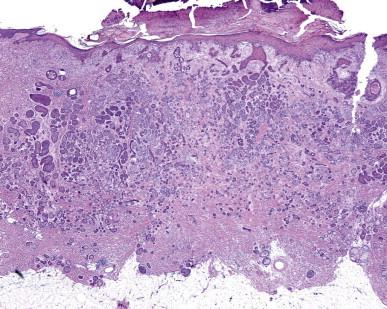
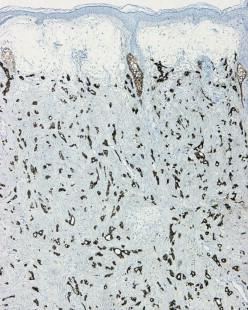
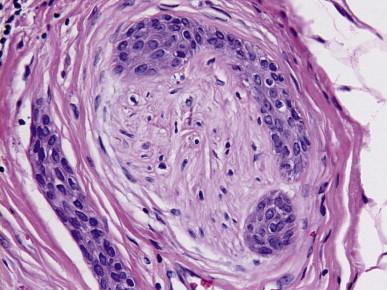
Several conditions enter into the differential diagnosis. The most likely lesion for MAC to be confused with is desmoplastic trichoepithelioma. The MAC cells resemble those of syringomas and poromas, while the ones from trichoepitheliomas resemble those of basal cell carcinomas with more angulated cell cords. Both lesions may deeply penetrate the dermis, but the characteristic perineural invasion of MAC is not seen in desmoplastic trichoepithelioma. Syringoma, particularly the plaque-type variant, and infiltrative basal cell carcinoma may also pose diagnostic problems. Syringomas tend to be more superficially located and usually occur periorbitally, while basal cell carcinomas have retraction artifact and an epidermal connection.
Treatment options include standard surgical excision, Mohs micrographic surgery (MMS), irradiation, chemotherapy, and observation. While MACs are typically thought to be locally aggressive with a propensity for recurrence, there have been several reported cases with hematogenous, lymphatic, and/or perineural spread with both regional and distant metastases, resulting in at least one death.
True adenoid cystic carcinoma of the skin is a very rare lesion which was first described by Boggio in 1975. This neoplasm most commonly occurs on the scalp and typically affects middle-aged to elderly females. Lesions arise as an asymptomatic crusted verrucous plaque or deep-seated nodule.
The solid to cystic dermal nests of adenoid cystic carcinoma have no connection to the overlying epidermis, have a swiss-cheese, cribriform, or sieve-like appearance, and are composed of small, basophilic cells with scant cytoplasm ( Fig. 13.4 ). An important diagnostic clue is the extensive perineural invasion ( Fig. 13.5 ).
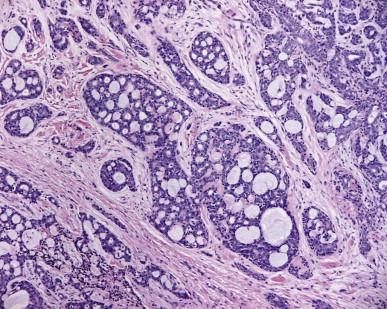
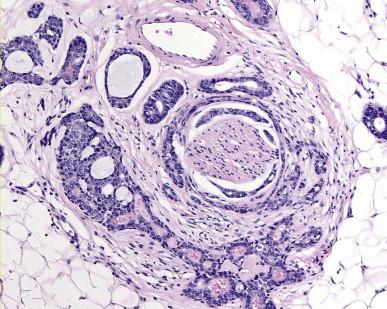
Histologically, adenoid cystic carcinoma poses a difficult differential with the so-called ‘adenoid cystic’ variant of basal cell carcinoma. The epidermal origin of basal cell carcinoma is helpful, as is the prominent perineural invasion common in adenoid cystic carcinoma. Primary salivary gland adenoid cystic carcinoma can, rarely, directly invade or metastasize to the skin and should be considered in the differential diagnosis.
Adenoid cystic carcinomas have an indolent but progressive course with a high rate of local recurrence. However, recurrence rates have been lowest when Mohs technique is used. Metastases have been reported in the lungs and pleura and in lymph nodes. Close long-term follow-up is necessary.
Mucinous carcinoma is one of the most common adnexal carcinomas of the skin. The lesion was originally described by Lennox et al. in 1952. The tumor presents as a painless slow-growing solitary nodule that is usually flesh colored, and has a soft, spongy consistency. These tumors often can be transilluminated.
The large majority of lesions are located on the head and neck, with a predilection for the eyelids. Lesions occur in twice as many females as males and typically present between the ages of 31 to 89.
Grossly, mucinous carcinomas have a lobulated, mucoid, glistening appearance. Histologically, they are composed of cords, tubules, and lobules of epithelial cells, floating in large pools of slightly basophilic mucin, separated by thin fibrovascular septa ( Fig. 13.6 ). The neoplastic epithelial cells have bland cytological features with monomorphous round nuclei ( Fig. 13.7 ).
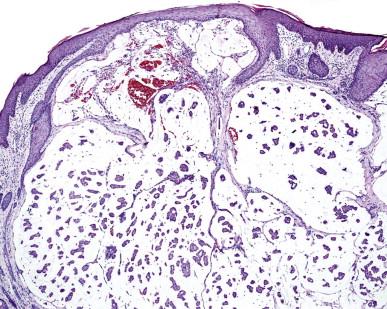
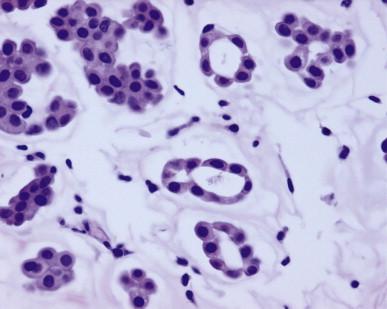
The most important differential diagnosis is metastatic mucinous carcinoma, particularly originating from the breast or gastrointestinal tract. Cutaneous metastasis of breast carcinoma typically occurs in the chest, breast, and axilla, whereas primary cutaneous mucinous carcinoma is predominantly located on the head and neck. Morphologically, primary gastrointestinal carcinomas metastatic to skin have cytological pleomorphism and dirty necrosis, which are not seen in primary cutaneous mucinous carcinomas. In addition, the presence of sulfomucins is highly distinctive of carcinomas of gastrointestinal origin, while sialomucins are generally seen in primary cutaneous mucinous carcinoma.
Treatment includes wide local excision with clear margins. Success has been reported with MMS. Cutaneous mucinous carcinoma usually has an indolent course. Recurrence typically occurs in the first few years. While this tumor generally has a low metastatic potential, regional and distant metastases have been reported.
Become a Clinical Tree membership for Full access and enjoy Unlimited articles
If you are a member. Log in here